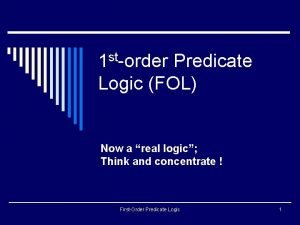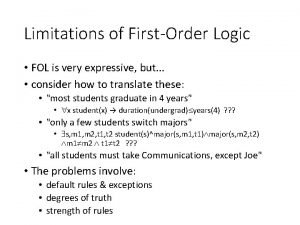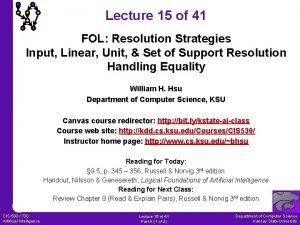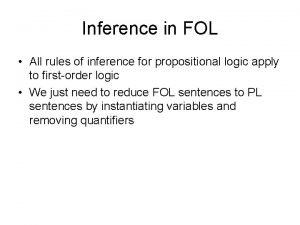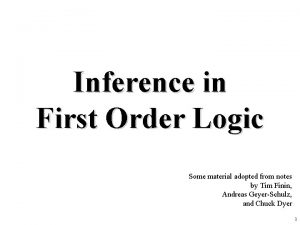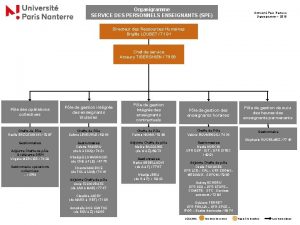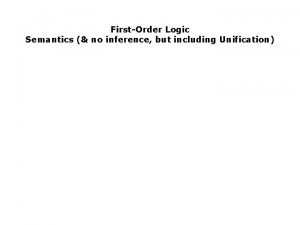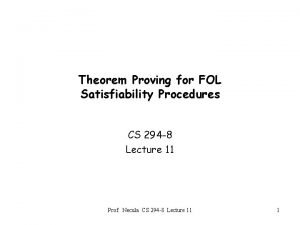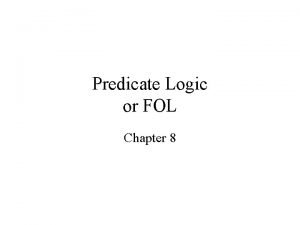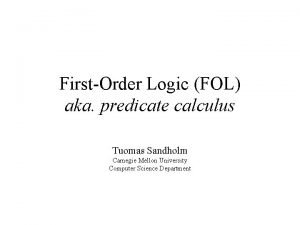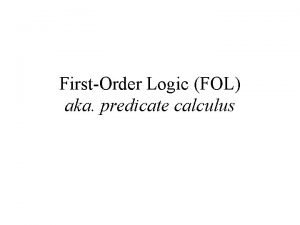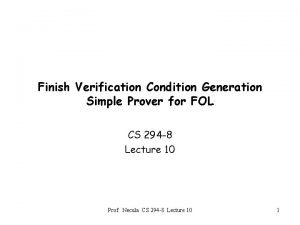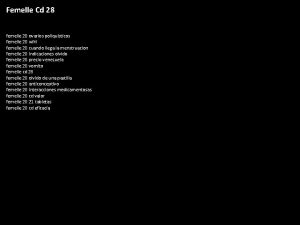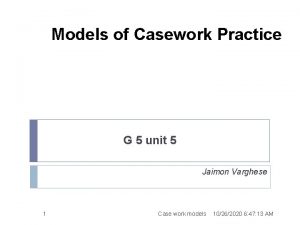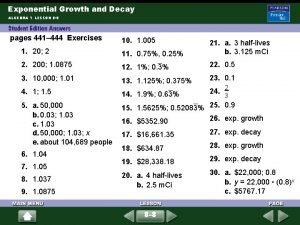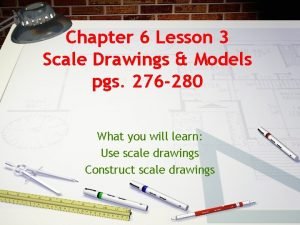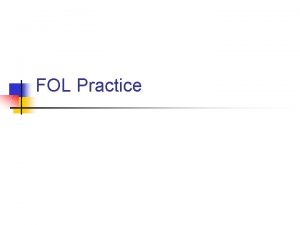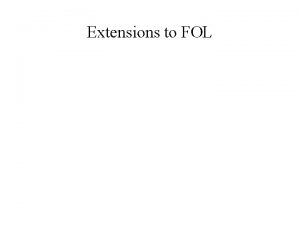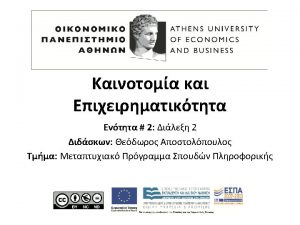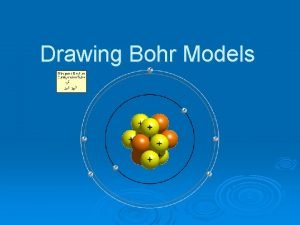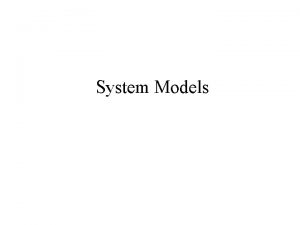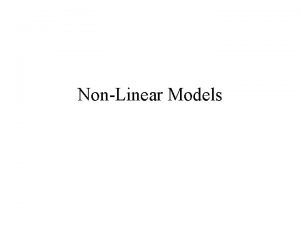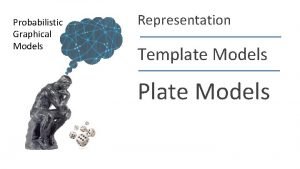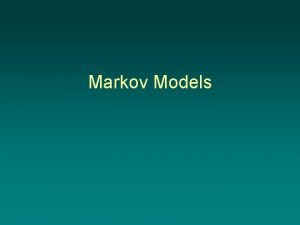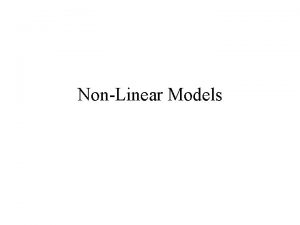FOL Practice Models n A model for FOL




















- Slides: 20

FOL Practice

Models n A model for FOL requires 3 things: n n n A set of things in the world called the UD A list of constants A list of predicates, relations, or functions

The Marble World UD: Ashley, Clarence, Rhoda, Terry, and their marbles a: Ashley c: Clarence r: Rhoda t: Terry B(x): x is blue G(x): x is green R(x): x is red S(x): x is a shooter C(x): x is a cat’s-eye T(x): x is a steely M(x): x is a marble B(x, y): x belongs to y W(x, y): x wins y G(x, y, z): x gives y to z

Some Examples n n All the cat’s-eyes belong to Rhoda. All the marbles but the shooters are cat’s eyes. Some, but not all, of the cat’s-eyes are green. All of the shooters that are steelies belong to Terry. n n ( x)(C(x) B(x, r)) ( x)[(M(x) & ~S(x)) C(x)] ( x)(C(x) & G(x)) & ~( y)(C(y) G(y)) ( x)[(S(x) & T(x)) B(x, t)]

WFFs and Truth in FOL n n n Before we can decide if a sentence in FOL is true, we need to make sure it is well-formed Once this is determined, we can test if a sentence is true in the model. Let’s look at a less complicated model to practice this…

The Positive Integer Model UD: positive integers a: 1 b: 2 E(x): x is even O(x): x is odd L(x, y): x is larger than y Eb & (Ob Lba) WFF? True? Test for truth by looking at the truth of each subsentence Eb: 2 is even (TRUE) Ob: 2 is odd (FALSE) Lba: 2 is larger than 1 (TRUE) T & (F T) => T & T =>T

More Truth n When quantifiers are involved, it is more complicated n x means “No matter what you choose for x…” n n n UD = Giant Bag o’ Stuff A universal statement has to be true for every item in the UD x means “There is at least one x such that…” n An existential statement is true as long as it is true for at least one thing in the UD

Practice n Every positive integer is either odd or even and no positive integer is both. n n Paraphrase: No matter what x you choose, either x is even or x is odd and it is not the case that there is a y such that both y is even and y is odd. Symbolization: x(Ex Ox) & ~ y(Ey & Oy)

x(Ex Ox) & ~ y(Ey & Oy) n Is this true in the model? n n Is x(Ex Ox) true? n n This statement is false if we can find just one item from the UD that makes it false, which we can’t! It’s TRUE. Is ~ y(Ey & Oy) true? n n Remember that &-statements are true if both conjuncts are true. This statement is true if y(Ey & Oy) is false. Is there something in the UD that is both even and odd? There isn’t, so y(Ey & Oy) is false which makes ~ y(Ey & Oy) TRUE. Therefore, the entire statement is true in the model.

Creating Dummy Models n n So far, we have looked at whether a sentence is true in a given model. Models don’t have to be complicated things dealing with real properties of real world things. n We can create a dummy model using a diagram to help predict if a FOL sentence or argument has particular properties.

What We Can Do with Models n True/False on a model n n True/False on all models n n We can show that a sentence is true/false on all models or if it is indeterminate Consistency n n We can give a model that makes a sentence true/false We can check if a set of sentences is consistent by giving a model where they are all true Validity n We can check if an argument is invalid by giving a model where the premises are true but the conclusion is false

Strategy for Model Creation n n Represent constants with a dot Represent properties with a circle n n n Anything that falls in the circle has that property; anything not in the circle doesn’t Represent relations with an arrow Getting a model from the picture n n Put any dots in the UD List the dots as constants For each predicate, give a set that lists the dots in the predicate’s circle For each relation, give a set of ordered pairs

Example 1 n Give a model that makes the sentence Nad -> ~Nda true. a d § Give a model that makes the sentence Iap -> (Ipa -> Iaa) false. a p

Example 2 n Show that (Ga & x. Bx) y. By is not true for every model n Paraphrase: If both a is in G and there is something in B, then everything is in B. UD: a, b G(x): {a} G B B(x): {b} a b a: a b: b

Example 3 n Show that x. Gx & y z(Fyz Gz) is not true for every model n Paraphrase: There is something in G and everything that is pointed to with F is in G. UD: a, b G a: a a b b: b G(x): {a} F(x, y): {<a, b>, <b, a>}

What good are dummy models? n Dummy models are quick way to discover a property of a sentence n n Once we know that property, it will still hold no matter what the model is So, if we can show that a sentence is true on at least one model, we know we can come up with a real world model that it is also true on

Back to Example 2 n n We know that (Ga & x. Bx) y. By is not true for every model. We can use the dummy model as a template for a real world model UD: a, b Gx: {a} Bx: {b} a: a b: b UD: Homer, Otis Gx: x is yellow Bx: x is black a: Homer b: Otis

Arguments n An argument consists of a set of premises and a conclusion n n An argument is valid if and only if it is not possible to give a model that makes the premises all true and the conclusion false So, to show that an argument is invalid, give a model where the premises are true and the conclusion is false n An invalid argument is always invalid! It may be possible to give a model that makes it seem like a good argument (politicians do this all the time!), but you can use the dummy model method to easily figure out if the argument is really any good.

Example 4 n Show that the following argument is invalid: x(Fx Gx) ~ x. Fx ~ x. Gx “Everything in F is in G” “Nothing is in F” “Nothing is in G” UD: a, b F a G b Fx: {} Gx: {b} a: a b: b UD: Homer, Shai (the very furry bunny) Fx: x is a cat Gx: x is furry a: Homer b: Shai

That’s it! n As you are working on the argument you give in your paper, you may want to think about how it might look in FOL n n n Is your argument valid? ? ? Remember: Paper outlines are due on Friday by the end of the day (e-mail before 11: 59 pm is OK) No reading for this week!
 Fol is a
Fol is a Fol in ai
Fol in ai Resolution in fol
Resolution in fol Inference in fol
Inference in fol Resolution in fol
Resolution in fol Resolution in fol
Resolution in fol Predicate logic tutorial
Predicate logic tutorial Spe nanterre
Spe nanterre Unification first order logic
Unification first order logic Cs fol
Cs fol Fol eol
Fol eol Conjuctive normal form concentrates on eliminating
Conjuctive normal form concentrates on eliminating Fol procedure
Fol procedure Forward chaining
Forward chaining Fol
Fol Vexa cd engorda
Vexa cd engorda Semi-modals
Semi-modals Models of case work
Models of case work Practice 8-1 exploring exponential models answers
Practice 8-1 exploring exponential models answers 7-7 practice scale drawings and models
7-7 practice scale drawings and models Remedial model
Remedial model
